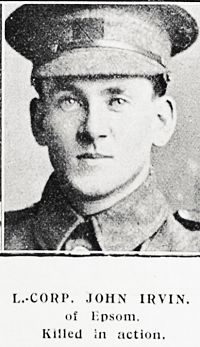WW1 Irving Brothers — Augustus and John
Edward Augustus (1867-1918) and Jane (nee Ross) (1869-1958) Irving, were married in 1888, and lived at 260 Remuera Road, Remuera, Auckland.
They had ten children, six sons and four daughters, of which two sons, Augustus and John fought and perished on the Western Front in World War One. Augustus was in the New Zealand Rifle Brigade, B Company and John was in the Rifle Brigade, C Company. Augustus Irving was killed on 7 June 1917 at Messines (Mesen) and John Irving, the eldest son, at Passchendaele (Passendale) on 12 October 1917.
Augustus Irving (also Irvin) was the third son of six sons and four daughters of Edward Augustus (1867-1918) and Jane (Ross) (1869-1958) Irving, living at 260 (probably now 682) Remuera Rd., Remuera, Auckland, New Zealand. He was born 1 August 1893 in Kawakawa, Bay of Islands, New Zealand. Augustus’s eldest brother John (28 September 1888 – 12 October 1917) also served in World War I Before his enlistment, Augustus was a Mill Hand, working for W. Smith of Kawakawa. He was also in the 15th NA (North Auckland} Regiment, but was discharged for medical reasons, for the treatment of a diseased bone in his leg.
He enlisted 7 February 1916, in Whangarei, as a Rifleman in 3rd New Zealand Rifle Brigade, 3rd Battalion, B Company. He was 5ft 7inches (1.70m) tall, fair complexion, blue eyes and brown hair, his leg having caused him no further problems. He sailed on 27 May 1916 from Wellington, New Zealand to Devonport, Devon, England HMNZT 55 ‘Tofua’ and arrived on 27 July 1916. He left Sling Camp for the Etaples Camp in France in August 1916 as part of the 3rd Battalion. On 23 March 1917, he was admitted to hospital with mumps, from which he recovered and returned to the Battalion on 10 April 1917 situated on the Western Front [2]
Augustus Irving fought in the battle for and capture of Messines (now Mesen) a ridge south of the town of Ypres (Ieper today). A stunning success, Messines was captured by 12 British, Australian and New Zealand divisions on 7 June 1917, heralded by the thunder of mine explosions. In the New Zealanders’ sector, as in the others, there was little immediate enemy artillery fire, so well had the artillery suppression plan worked. The leading elements were across no-man’s land before the German gunners began to respond. This paved the way for the main attack later in the summer by removing German forces from the dominating ground on the southern face of the Ypres Salient. New Zealand suffered 3,000 casualties and 700 deaths including Augustus Irving. [3] He was killed on 7 June 1917 and buried 450 yards from where Stinking Farm Road cuts Messines Hill, just south west of Messines, in Belgium at Messines Ridge British Cemetery, Mesen, West-Vlaanderen, Belgium, I. D. 27 He was posthumously awarded the British War Medal and Victory Medal.
John Irving (also Irvin) was born on 28 September 1888 in Ruapekapeka, Bay of Islands to Edward Augusts (1867-1918) and Jane (Ross) (1869-1958) Irving, of 260 Remuera Rd., Remuera, Auckland, New Zealand. John’s younger brother Augustus (1 August 1893 – 7 June 1917) also served in World War I Before John enlisted as a Private on 27 May 1915 at Trentham, he was working as a Labourer, at the Kauri Timber Company, Waipuna, Northland. He was 26 years 7 months of age, 5ft 4 1/2inches (1.64m) tall, had a fair complexion, blue-grey eyes and light brown hair.
He sailed on ‘Tahiti’ on 9 October 1915 from Wellington and arrived in Suez, Egypt, on 22 November 2915 as a Rifleman, in C Company, New Zealand Rifle Brigade, 2nd Battalion He was stationed in Egypt and Ismailia, where the key goal of the campaign was to secure the Suez Canal from the threat of Ottoman attack from the Sinai Peninsula. The canal was a vital transport route that allowed Allied shipping to pass directly from the Indian Ocean to the Mediterranean Sea and Europe, avoiding the need to travel all the way around Africa and through the South Atlantic Ocean.
On 6 April 1916, he sailed to France at the time when most of the New Zealand Expeditionary Force sailed to France for the Western Front. On 7 October 1916, he was transferred to the bombing section “for pay and discipline” until 11 December 1916 when he was transferred back to C Company. On 30 May 1917, he was detached to the Rifle Brigade and a week later, was promoted to Lance Corporal.
The next offensive was to capture Ypres (Ipres), Belgium on 12 October 1917, where the British Commander-in-Chief Sir Douglas Haig’s, hope rested. There was little time to prepare for this attack, the weather was very wet and the ground muddy. The batteries were set up in mud, with limited ammunition. The 3rd (Rifle) Brigade pushed forward to take the Bellevue Spur, near the Passchendaele ridge till they were halted by machine-gun fire. The 2nd Brigade rapidly came up against barbed wire that sloped obliquely across the New Zealand front. A few determined individuals got through the barrier, but they were quickly killed. Most of the rest were forced to take cover in shell holes. [4] John Irving was in the action at Ypres, where he was killed on 12 October 1917 and is buried at Tyne Cot Cemetery, Zonnebeke, West-Vlaanderen, Belgium, Grave reference XXIX. D. 15.
He was posthumously awarded the 1914-1915 Star, British War Medal, and Victory Medal.

